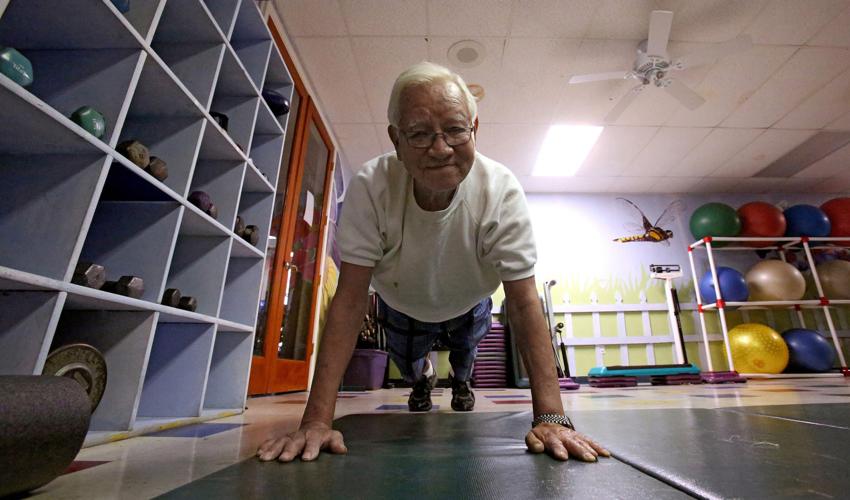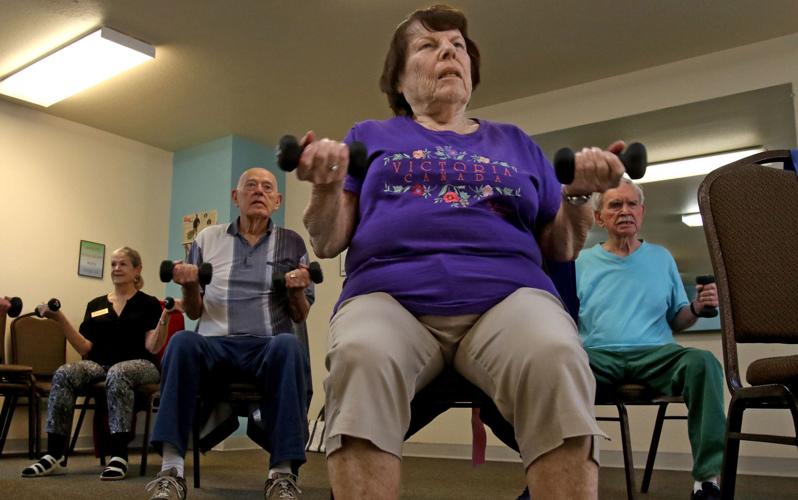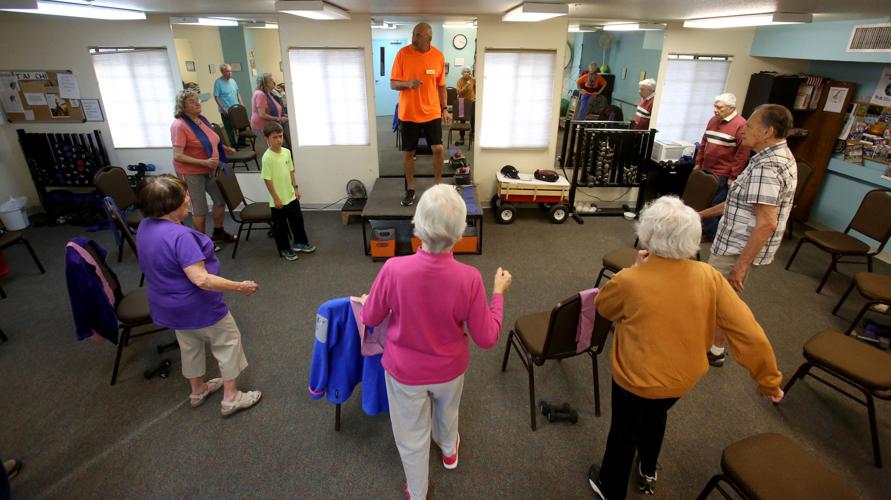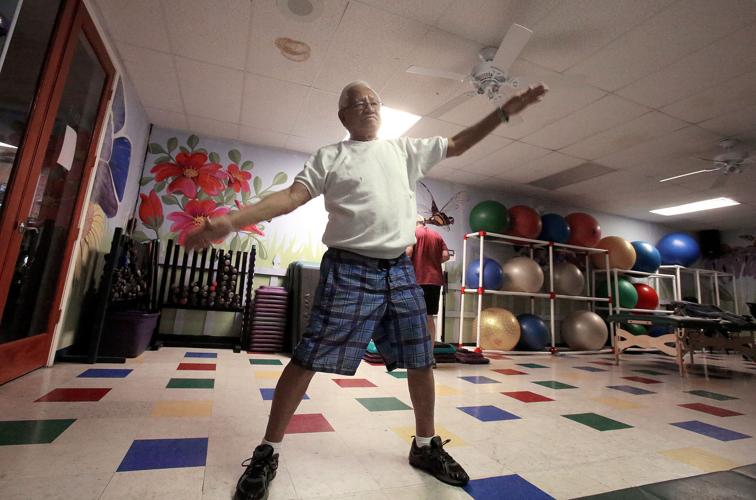Dellora “Dee” Cohen keeps her activities calendar in the kitchen and takes a look at it before she walks out of her casita to begin her workouts at The Fountains at La Cholla on the northwest side.
The 93-year-old woman breaks a sweat doing line dancing as she moves to the electric slide. Each year she has a blast performing for residents, dressing up with bling and showing her moves to the cha-cha, rumba, fox trot, swing and waltz.
Then there is Rosendo Galindo, 97, who lives in Tucson’s midtown and works out five days a week at Mid-Valley Athletic Club. He stopped driving last year, so his daughter drops him off at the club where he uses weights, does stretching and strengthening exercises for his bones and muscles, along with aerobics in the pool.
The two are among a growing number of seniors who are living longer and enjoying a better quality of life because of exercise and living well.
“What researchers say, over and over, is that positive perceptions of aging may affect your physical and mental health,” said Adina Wingate, a Pima Council on Aging spokeswoman.
Findings show that exercising and eating healthy, making friends and enjoying life can help people live an average of 7.5 years longer.
“In Pima County, the fastest-growing age band is age 85-plus,” said Wingate.
PCOA, a nonprofit council that serves older adults and their families, estimates there are 240 people age 100 or older living in Pima County, and some 832 statewide. The council identified 109 centenarians in Pima County last year. An assessment using U.S. Census Bureau data came up with the current figure of 240, explained Wingate.
Pima County demographics shows 24.6 percent of all residents are age 60 and older. In 2017, Arizona’s population was estimated at 7 million and by 2020, one in four Arizona residents will be 60 or older, according to state projections.
“Physical activity is important for healthy aging,” said Jane Mohler, a University of Arizona professor at the medical school, and a research associate for Arizona Center on Aging. The center promotes healthy and functional lives for older adults through comprehensive programs in research, education and training, and clinical care.
Exercise builds cognitive and physical resilience and helps change the slope of our decline as we age, Mohler said. Key benefits of exercise for older adults found on the Arizona Center on Aging web site include reduction in chronic low-grade systemic inflammation; improved balance, memory attention and reaction times; increased heart rate and lowering of blood pressure; improved blood-sugar levels for diabetics; increased muscle and bone mass, and flexibility.
“All of us want to maintain our independence and well-being,” said Mohler, explaining that falling, cognitive impairment and frailty all represent loss of independence. “Cognitive decline can be staved off or slowed by physical activity.”
At 93, Cohen feels fortunate to feel good and have the ability to stay active. On a recent day, she was dressed in black capris, a red blouse and sandals while working out in a dance class.
Other days, the 4-foot-11-inch-tall woman with short, dark brown hair and hazel eyes does yoga, tai chi and exercises with weights and bands.
Cohen’s daughter, Leslie Cohen, said she remembers her mother becoming interested in the first wave of aerobics when she was 50. She joined a health club and has remained active. “She is very forward-thinking and sees what the next adventure is in store for her.”
A Chicago native and a retired dietitian who worked for the veterans hospital in Oklahoma City, Cohen volunteers in the library and sits on the food-service committee at her retirement community.
She often goes on planned trips for residents, including overnight stays in Tubac, or spends time with her daughter attending Tucson Symphony Orchestra performances and traveling. The two are looking forward to a trip in May to Portland, Oregon, where they will celebrate with Cohen’s son the graduation of his son from law school at Lewis & Clark College.
“I enjoy my life. I stay positive and keep active. I can’t believe I am this old. I don’t feel old,” said Cohen, a breast-cancer survivor. She and her husband, a retired attorney who died in 2005, moved to Tucson in 2003 to live close to their daughter.
The retirement community where Cohen lives serves nearly 500 residents, said Fran Donnellan, executive director of The Fountains at La Cholla. She said she is inspired every day by amazing people between the ages of 65 to 106. “Every year the technological, medical and healthy advances seem to keep our residents more and more vibrant and active,” Donnellan said.
For Galindo, Mid-Valley Athletic Club is a hub for exercise and socializing. Since 1993, he has spent about three hours daily at the club. “I used to lift weights, but I am too old now,” said Galindo, proudly mentioning when he was young he leg-pressed 320 pounds.
Now three years shy of becoming a centenarian, Galindo does water aerobics, lots of stretching and works with weights that he can handle. “I recommend to all elderly to lift your feet when you walk. Don’t shuffle. I walk holding 3- to 5-pound weights,” said Galindo, who manages his blood pressure and diabetes with medications.
He also rides a stationary bike and works his arms, shoulders, biceps and abdominal muscles on stationary equipment. “I like all forms of exercise. I feel like I am 15 years old,” he said glancing at his wife, Maria del Socorro, 87. The couple married nearly 65 years ago and raised four children, have six grandchildren and five great-grandchildren.
Galindo is a native of Nogales, Sonora, who moved to Arizona in 1956 and became a naturalized citizen. He retired in 1992 from the city of Nogales as an operations/maintenance supervisor and moved to Tucson.
“My dad has always been active,” said Rosendo’s daughter, Lupita Galindo. “When I was young, I remember him going for walks at the school’s track. His outlook on life has always been bright and positive. He is friendly and loves to socialize and make friends. That is another reason he likes to go to the club — he goes out and eats with friends and celebrates their birthdays,” she said.
Carolyn LeCocq, an owner of the athletic club, is a retired nurse who worked with elderly patients. She said Rosendo Galindo is a joy to work with, noting the club has several members nearing 100 and some who are centenarians.
In 1992, LeCocq and her husband promoted Silver Sneakers, a fitness program for people age 65 and over. Those with qualifying health plans receive a free membership to the gym to participate in the fitness program.
“Physical activity is so important for seniors because it makes you stronger and clubs are a good place to socialize and get people out of the house,” said LeCocq, whose trainers are certified by the program and can work with people who have physical disabilities.
She said many seniors inquire about the aquatic classes and they ask if they have to wear bathing suits. “I say, ‘No, but you have to wear something.’” Her answer makes people bust out in laughter.
“My message to seniors is ‘do whatever you can do, but do something and keep moving,’” said LeCocq, 65. “I love working with older people because they have all the knowledge in the world — they are wiser and smarter,” she said.
Physical activity guidelines still recommend 300 minutes a week of exercise, but “short bouts of intense activity may be as good or better for you as the long bouts,” said Mohler, explaining that instead of an hour workout, a 7- to 10-minute challenging workout increases mass in your brain.
“People have to start while you still have capacity and continue because if you don’t use it you lose it. You have to fire it to wire it,” she said stressing the dual-task of simultaneously challenging the body and mind while exercising.








